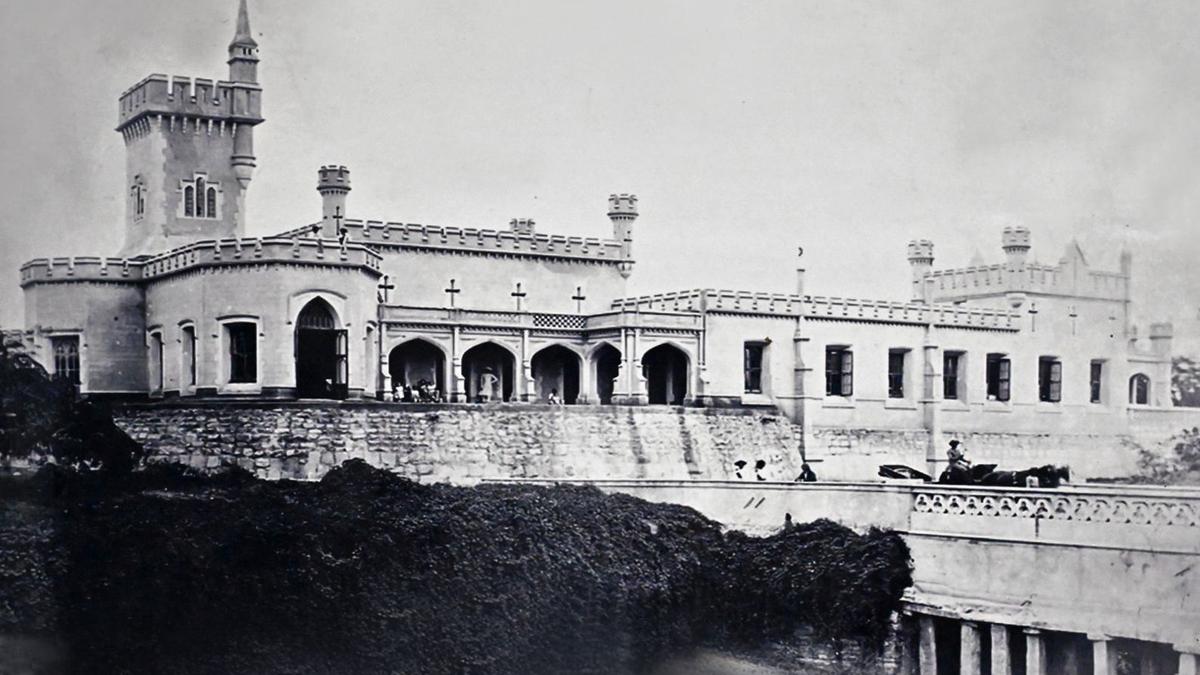
Brett’s Folly: Brett was so enthusiastic that he had the plan for the castle drawn in England and raised even new hamlets around this building for chunnambu
suppliers and masons. The castle was completed in 1861.
| Photo Credit: Special Arrangement
In 1987, when I was posted as the Deputy Inspector-General of Police, Vellore Range, I used to traverse by the lake in Hosur, often wondering at the remnants of a grey, dilapidated yet stately castle-like building with tall broad walls and steep spires that looked completely alien to its surroundings. I often wondered who the builder of this castle was and who its occupants were. Who would have given the tinge and character of a medieval British castle to this part of Tamil Nadu?
Whenever I took a break from the vagaries of work, I enquired with old constables, old revenue officials, old Hosur residents, and retired officers about the castle; but invariably I would get no information.
But, while reading about Hosur recently, I chanced upon a reference to this castle. This castle was built by a British ICS Collector by name Brett to accommodate the lady who was to be his wife. She had imposed a condition that he should build — before her arrival in India — a castle modelled on Kenilworth Castle in Warwickshire, England, for her to stay with him.
A tahsildar put in charge
The lovelorn ICS officer, to meet the desire of his lady, chose the ramparts that existed on the moat at Hosur and commissioned construction of the castle under the direct supervision of a tahsildar in 1857 who after sometime lost count of the expenses incurred and gave up accounting once and for all. Brett was so enthusiastic that he had the plan for the castle drawn in England and raised even new hamlets around this building to accommodate chunnambu suppliers and masons. The castle was completed in 1861.
Hosur then was the headquarters of Salem district. But, to the luck of Brett, the district headquarters was shifted to Salem the same year and Brett and his betrothed did not have the fortune even to set foot in the Hosur castle that was so lovingly built. They went to Salem and Brett’s Scottish wife died while being there and now lies buried in St. John’s Cemetery in Bengaluru, Karnataka.
The castle, nicknamed ‘Brett’s Folly’ by other officials, housed for some time the residence and office of the Sub-Collector of Hosur and then fell into disuse. The office of the Sub-Collector then moved to the present edifice in 1875 — a solid, well-kept building that will defy time for another 100 years.
Having learnt this much about the forlorn castle, I thought I should visit Hosur to have a leisurely look at the fort and its interior. I went round and round the lake and the now very busy Hosur town, but I could not find any trace of the castle.
Disappointed, I went to the police station seeking help to locate the castle. The younger constables and bystanders were quite ignorant of the place. However, a middle-aged head constable had knowledge of the locale and escorted me to a mound, saying that the castle in the last 30 years had been reduced to rubble and only a few blocks of stones hidden under thorny bushes and wild growth were all that one could construe as the castle.
When I saw the heap of rubble, rubbish, and heaps of night soil, in the place where the castle once stood, the words, “sceptre and crown must tumble down”, lingered in my ears. The only redeeming feature in the area was a new temple that had come up in the midst of this ruin.
Trenches and dungeons
In the course of the conversation, the head constable mentioned that in the camp office of the Sub-Collector there are still photos of the original castle. Legend has it that the castle houses trenches and dungeons, now closed, and during one of its excavations, the excavator unearthed cannonballs. Further, it was said that there lurked a huge snake in the fort which a British Sub-Collector shot at, and consequently fell ill. Brett was dismissed from service by Lord Cornwallis for mismanagement of company funds.
I visited the present office of the Sub-Collector and the vast palatial residence, called Whispering Willows, and saw the photographs of the stunning castle. The office of the Deputy Superintendent of Police is equally palatial, reflecting the Raj that once was.
Construction of such impressive buildings for officers signifying the might of the administration is a thing of the past. But one is thankful that the Sub-Collector has preserved the photographs of the castle. Hopefully for posterity.
(The writer is a former DGP of Tamil Nadu.)
Published – July 04, 2025 09:00 am IST



